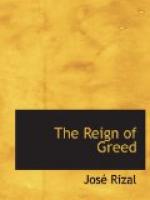tienda: A shop or stall for the sale of merchandise.
tikbalang: An evil spirit, capable of assuming various forms, but said to appear usually as a tall black man with disproportionately long legs: the “bogey man” of Tagalog children.
tulisan: Outlaw, bandit. Under the old regime in the Philippines the tulisanes were those who, on account of real or fancied grievances against the authorities, or from fear of punishment for crime, or from an instinctive desire to return to primitive simplicity, foreswore life in the towns “under the bell,” and made their homes in the mountains or other remote places. Gathered in small bands with such arms as they could secure, they sustained themselves by highway robbery and the levying of black-mail from the country folk.
NOTES
[1] The Spanish designation for the Christianized Malay of the Philippines was indio (Indian), a term used rather contemptuously, the name filipino being generally applied in a restricted sense to the children of Spaniards born in the Islands.—Tr.
[2] Now generally known as the Mariquina.—Tr.
[3] This bridge, constructed in Lukban under the supervision of a Franciscan friar, was jocularly referred to as the Puente de Capricho, being apparently an ignorant blunder in the right direction, since it was declared in an official report made by Spanish engineers in 1852 to conform to no known principle of scientific construction, and yet proved to be strong and durable.—Tr.
[4] Don Custodio’s gesture indicates money.—Tr.
[5] Duck eggs, that are allowed to advance well into the duckling stage, then boiled and eaten. The senora is sneering at a custom among some of her own people.—Tr.
[6] The Jesuit College in Manila, established in 1859.—Tr.
[7] Natives of Spain; to distinguish them from the Filipinos, i.e., descendants of Spaniards born in the Philippines. See Glossary: “Indian.”—Tr.
[8] It was a common saying among the old Filipinos that the Spaniards (white men) were fire (activity), while they themselves were water (passivity).—Tr.
[9] The “liberal” demonstrations in Manila, and the mutiny in the Cavite Arsenal, resulting in the garroting of the three native priests to whom this work was dedicated: the first of a series of fatal mistakes, culminating in the execution of the author, that cost Spain the loyalty of the Filipinos.—Tr.
[10] Archbishop of Manila from 1767 to 1787.—Tr.
[11] “Between this island (Talim) and Halahala point extends a strait a mile wide and a league long, which the Indians call ‘Kinabutasan,’ a name that in their language means ‘place that was cleft open’; from which it is inferred that in other times the island was joined to the mainland and was separated from it by some severe earthquake, thus leaving this strait: of this there is an old tradition among the Indians.”—Fray Martinez de Zuniga’s Estadismo (1803).




